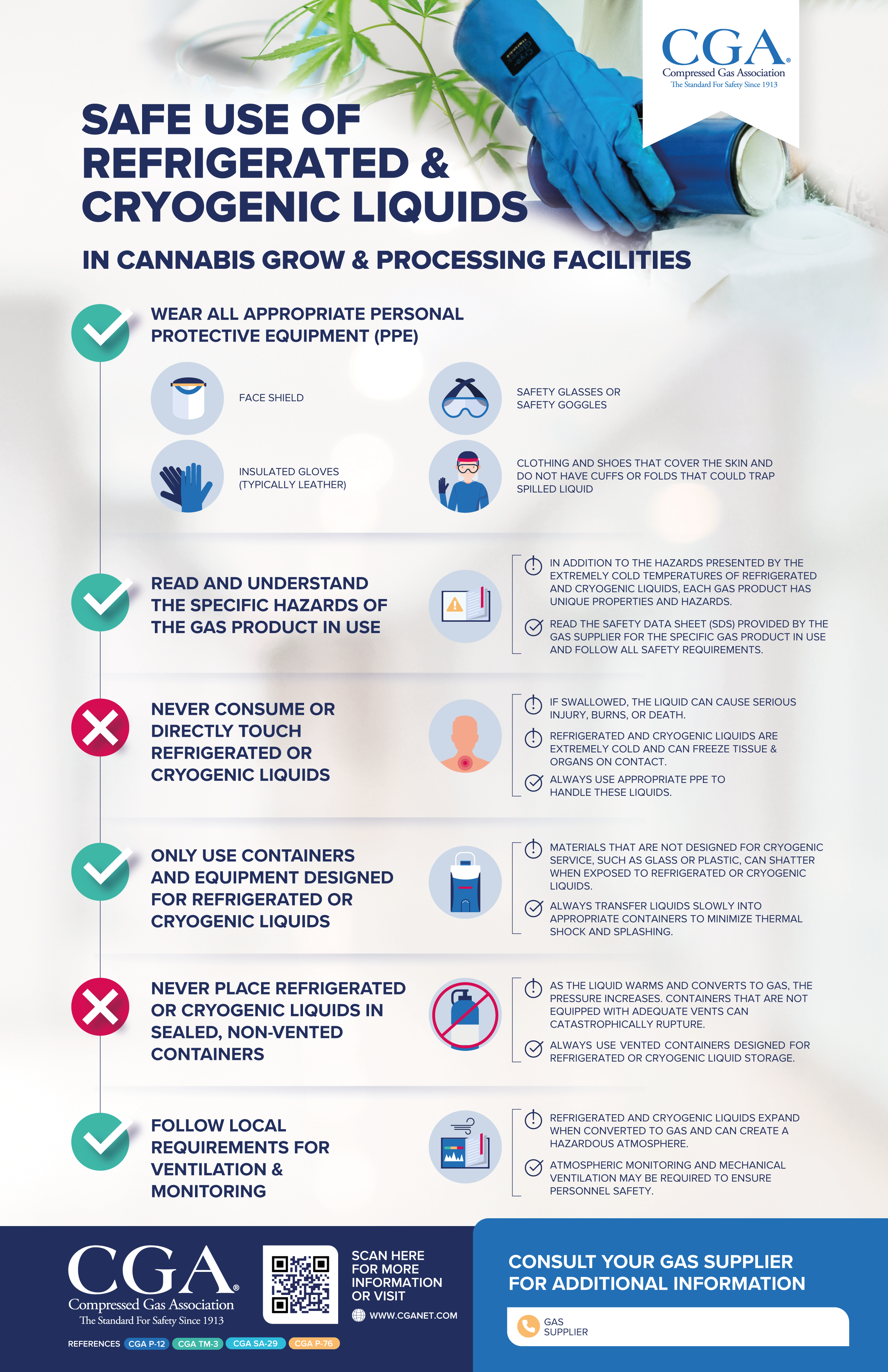Your Refrigerated and Cryogenic Liquid Safety Resource Center
Safe Use of Refrigerated & Cryogenic Liquids
Refrigerated and cryogenic liquids are gases that have become a liquid due to very low temperatures. These liquids are extremely cold; cryogenic liquids are defined as having a boiling point below –130 °F (–90 °C). Once liquefied, all refrigerated and cryogenic liquids must stay extremely cold or they will return to a gas state in a process known as vaporization.
Anyone who handles refrigerated or cryogenic liquids should be aware of their unique properties and potential hazards. In addition to being extremely cold, other hazards include high rates of vaporization, rapid expansion, and fogging. This safety poster, provided by the Compressed Gas Association, provides basic safety information for the safe use of refrigerated and cryogenic liquids.
The specific gas product being used can pose other hazards in addition to being a refrigerated or cryogenic liquid. The container label and safety data sheet (SDS) provide detailed hazard information and handling precautions. You should always read and understand the label and the SDS before using any product and should also follow the instructions and safety precautions provided by your product supplier.
Refrigerated & Cryogenic Liquid Safety Reminders
- Wear all appropriate personal protective equipment (PPE).
- Read and understand the specific hazards of the gas product in use.
- Never consume or directly touch refrigerated or cryogenic liquids.
- Only use containers and equipment designed for refrigerated or cryogenic liquids.
- Never place refrigerated or cryogenic liquids in sealed, non-vented containers.
- Follow local requirements for ventilation and monitoring.
Poster Downloads
CGA offers safety posters as educational resources to support the safe use of our industry’s products and equipment. It is important to note that these posters are not a substitute for reading and following codes and regulations, industry standards, and supplier instructions. Download your free poster today!
NOTE – Use self-print files for printing at your home or office, and full bleed files for professional printing.
Additional Resources
CGA Publications
CGA eLearning Modules
CGA Free Safety Materials
- CGA SA-29, Safety Alert: Hazards of Liquid Nitrogen in Near-Consumer Applications
- CGA SP-7, Safety Poster (Industrial), Proper Cart Usage for Liquid Cylinders
- CGA SP-8, Safety Poster (Industrial), Wear Recommended Personal Protective Equipment
- CGA SP-11, Safety Poster (Industrial), Plan Your Trip to Avoid a Tip
Product Information: Refrigerated & Cryogenic Liquids
Refrigerated and cryogenic liquids are gases that change to a liquid once they drop below a certain temperature, known as the boiling point, which is different for each product. Cryogenic liquids are defined as having a boiling point below –130 °F (–90 °C). For example, the boiling point for water is 212 °F (100 °C). Above this temperature, water vaporizes into a gas (steam). Between the boiling point and 32 °F (0 °C), water is a liquid. Likewise, refrigerated and cryogenic liquids turn into gas above their boiling points, and are liquids at temperatures below their boiling points. Once liquefied, all refrigerated and cryogenic liquids must stay extremely cold or they will return to a gas state in a process known as vaporization.
All refrigerated and cryogenic liquids have several common properties:
- extreme cold;
- high rates of vaporization;
- rapid expansion; and
- fogging.
In addition to the characteristics shared by all refrigerated and cryogenic liquids, each product has its own unique hazards that should be understood and managed through safe handling practices. Examples of other hazards that can be present include:
- asphyxiation from inert products such as helium, nitrogen, and argon, which can displace the oxygen needed to sustain life;
- fires that can result from releases of flammable products, like hydrogen, or burn more vigorously due to release of oxygen or other oxidizing gases;
- toxicity from products such as carbon monoxide, which can have adverse and sometimes permanent effects on your health; and
- reactivity of the product with other chemicals or materials, for example oxygen reacting with organic materials such as oil, grease, asphalt, or dirt.
To find the specific hazards are presented by the product that you are working with, you must read and understand the safety data sheet (SDS) and product label.



